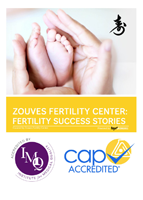
Zouves Fertility Center is pleased to offer Preimplantation Genetic Testing-Aneuploidy (PGT-A) in combination with IVF with Delayed Transfer.
PGT-A is the term that describes the process of analyzing the 23 chromosome pairs (22 autosomes, X and Y) of an embryo prior to transfer. Approximately 60% of early miscarriages are associated with chromosomal abnormalities. Chromosomally normal embryos cannot be identified by standard microscopic observation, but Preimplantation Genetic Testing-Aneuploidy can determine which embryos are chromosomally normal.
PGT-A is arguably the most useful breakthrough in assisted reproductive technology, and is achieved by removing 3 to 5 cells from an embryo at the blastocyst stage. The blastocysts are then vitrified (flash frozen) for preservation while PGT-A testing is completed. Those embryos with a normal complement of chromosomes are eligible for delayed transfer.
The combination of PGT-A and vitrification fits very well with IVF with Delayed Transfer. Transferring a single healthy embryo yields outstanding pregnancy rates, a lowered incidence of miscarriage and a lower risk of pregnancy with multiples.
Zouves Fertility Center embraced the concept of embryo testing for chromosome normalcy in 2001 through the use of associate reference laboratories. In April 2013, recognizing that the future of IVF is in the testing of the embryo, we decided to bring the technology of PGT-A completely “in house” so the logistics of offering PGT-A to every patient could be possible. At that time, array Comparative Genomic Hybridization (aCGH) was the state of the ART. Now, Next Generation Sequencing (NGS), an even more powerful methodology, is available and starting in January 2015, we are using the NGS platform by Illumina called Miseq.
Next generation sequencing has revolutionized the field of genetic testing. Unlike aCGH, NGS provides direct sequencing of embryo DNA. The thousands of DNA sequencing reads per chromosome can provide insight into partial chromosome gains or losses, as well as mosaicism that may have gone undetected with aCGH. This enhanced genetic information may allow us to select embryos for transfer with the highest possibility of implantation, healthy pregnancy and delivery. NGS provides DNA coverage, sensitivity and precision superior to any existing technology.
The graphs below were developed from the analysis of over 1500 embryos analyzed at ZFC. The tables below were developed from the 2-year and 1-year statistics for ovulatory patients that had PGT-A and delayed transfer using their own eggs.
The clinical pregnancy rate is defined by the presence of a fetal sac at 6 weeks of gestation. The implantation rate is the number of embryos transferred per fetal sac observed. The average number of embryos transferred indicates that most transfers were with single embryos.








